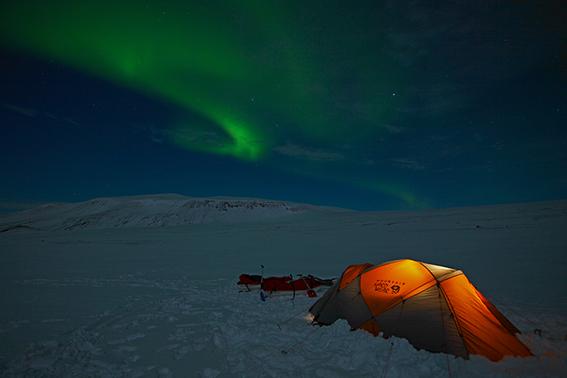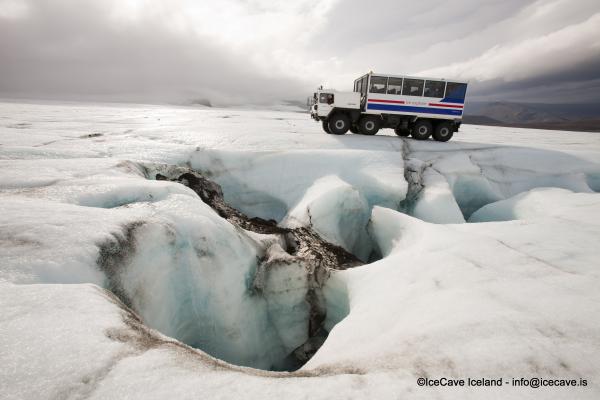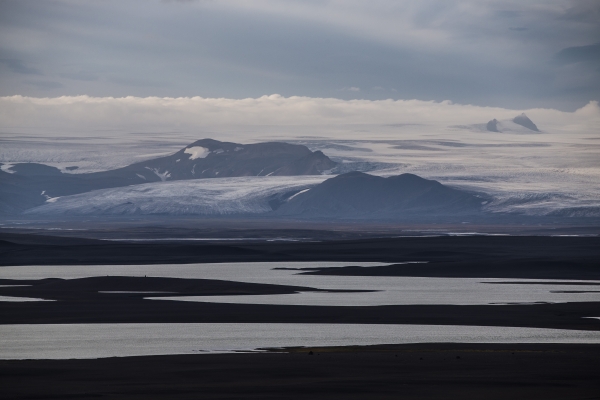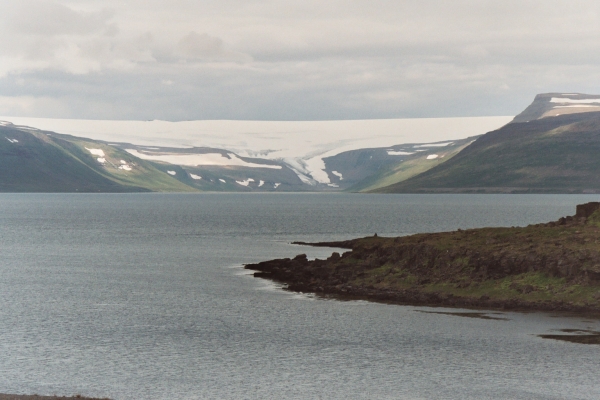Scientists have predicted that Iceland’s glaciers may disappear within the next 100 to 150 years if current trends of climate change are not reversed. And the outlook is not good at all. This year is set to become the warmest year recorded since mankind started instrumental observations.
Iceland’s glaciers have been retreating rapidly and losing volume for years, but they are still enormous. According to latest measurement they cover about 11% of Iceland’s 103.000 square kilometers (39.768 sq mi).
The largest by far is Vatnajökull, covering 8% of Iceland. It’s so big that you could easily fit all of Iceland’s other glaciers within its boundaries. Actually it’s so huge that you could fit the famous Mediterranean vacation islands Mallorca, Tenerife, Rhodes and Ibiza on it, with quite a few square km/mi to spare.
If you think that glaciers are just a lump of monotone whiteness of snow and ice, think again. Their visual impact can be borderline overwhelming. The colour palette ranging from all kinds of blue, grey, white and even volcanic black, and their surface ripped open by crevasses, which some seem to be bottomless, and barren peaks reaching through the ice.
The glaciers are also home to many of Iceland’s most notorious volcanoes, that regularly bring on a titanic struggle between fire and ice when the red-hot glowing magma is breaking its way to the surface.
And this is a world that you can easily visit and experience while you are in Iceland. You can do it on foot, skis or, in some places, be transported by snowmobile, super jeep or a pisten bully.
There are many guided tours available and we absolutely recommend travelling with an experienced guide. Glaciers can be a very dangerous place for the unfamiliar and the weather can turn in just a matter of minutes. Even on a bright and sunny day the wind can become almost unbearable on the glaciers (see one example below).
VATNAJÖKULL Southeast Iceland
How big is it?
Vatnajökull covers an area of 8,100 km² (3,100 sq mi), the ice cap is on average 400 m (1.300 ft) thick and around 1.000 m (3.300 ft) were it’s thickest. It’s Europe’s largest glacier by volume and area south of the Arctic Circle.
Any other records?
Iceland’s highest point, Hvannadalshnjúkur peak, is in Vatnajökull, standing at 2,110 meters (6.921 ft). It is located on the north-western rim of the ice covered crater of Öræfajökull volcano, one of the largest active volcano in the country (last eruption 1727-1728). In fact Vatnajökull is the home to many of Iceland’s active volcanoes, including Bárðarbunga, which is at the center of a 200 km (124 mi) long volcanic system, one of the largest on the planet. The 10 km (6,2 mi) wide caldera is located underneath a 600 to 850-meter (1,968 to 2,788 ft.) thick ice cap in Vatnajökull glacier.

Claim to Hollywood-fame
Vatnajökull (and some of the 30 outlet glaciers, that flow from the ice cap) can be spotted in various feature films and TV-shows. The imposing looking glacier is a stand-in for a far away planet in Chris Nolan’s Interstellar, it played a prominent role in Nolan’s Batman Begins movie, featured in the James Bond classic, A View to Kill and in the second season of Game of Thrones, just to name a few examples.
What can you do there?
There are various guided tours on offer. You can ski, hike, climb ice, snowmobile, take a super jeep tour on the glacier and you can scale Hvannadalshnjúkur peak. It’s recommended to travel with an experienced guide, as crevasses in the glacier can be difficult to spot and dangerous.
One of the best places to explore ice caves in Iceland is in the southern part of Vatnajökull, not far from the magical Jökulsárlón glacial lagoon.

LANGJÖKULL West Iceland
How big is it?
Langjökull is Iceland’s second largest ice cap covering 953 km2 (368 sq mi). The ice is up to 580 m (1,900 ft) thick. The highest point is called Baldjökull and is at the northern end of the glacier standing 1,450 m (4,760 ft) above sea level. Langjökull is Europe‘s second largest glacier south of the Arctic Circle.

Claim to fame
Langjökull is the home to a man-made Icecave, a 500-metre-long ice tunnel featuring a chapel, exhibition spaces and a restaurant.
What can you do there?
You can of course visit the Icecave, it's the only structure of its kind in Iceland. You can hike and ski on the glacier, you can even go camping and its vast ice plains makes it particularly well-suited for snowmobiling and super-jeep tours. Several companies offer trips for every level of skill and ambition.
HOFSJÖKULL The central highlands
How big is it?
Iceland’s third largest glacier covering 925 km2 (357 sq mi). Its highest point is 1,765 m (5,791 ft) above sea level. Under the ice cap is a huge dormant volcano.

Claim to fame
Hofsjökull is the source of Iceland’s longest river, Þjórsá, and several other rivers.
From September 2014 to September 2015 Hofsjökull gained mass for the first time in 21 years. M Iceland’s other glaciers have been retreating rapidly and losing volume for years.
What can you do there?
You can hike on the glacier but it’s steep, with deep crevasses and it’s difficult to negotiate. A trip on the glacier is only recommended for experienced and well prepared mountaineers. Hofsjökull is located in the center of central highlands and is due to the location and the challenging conditions much less travelled than Iceland’s other large glaciers.
MÝRDALSJÖKULL South Iceland
How big is it?
Mýrdalsjökull is Iceland's fourth largest ice cap covering 596 km2 (230 sq mi). Its located on the south coast. The summit is at 1.493 m (4.898 ft) above sea level.

Claim to fame
Mýrdalsjökull is the home to Katla, one of Iceland’s most feared volcanoes. The closely monitored magma chamber of Katla is 2 km (1.24 mi) below the top of the ice cap. Katla last erupted in 1918. Until then, eruptions at an interval of 13 to 95 years marked its history. Volcanologist expect it to blow its top any day now.
What can you do there?
You can hike, or take snowmobile tours on the glacier. Sólheimajökull, the long outlet glacier on the southwest side of Mýrdalsjökull, is a very popular travel destination. It's close to the Ring Route with a good parking space close by and it's easily accessible to hikers. Sólheimajökull has retreated up to 50 meters (164 feet) every year since 1986.
EYJAFJALLAJÖKULL South Iceland
How big is it?
Eyjafjallajökull is the sub-glacial volcano to the west of Mýrdalsjökull. It covers 78 km2 (30 sq mi) and its summit is 1.666 m (5,466 ft) high.
Claim to fame
When Eyjafjallajökull erupted in 2010 it was felt around the northern hemisphere. The dispersal of the ash cloud shut down all aviation across the North Atlantic for one week; 313 airports were closed and 104,000 international flights between Europe and North America were cancelled.
What can you do there?
You can hike on the glacier. Between Eyjafjallajökull and Mýrdalsjökull is one of Iceland’s most popular hiking route Fimmvörðuháls pass.
Claim to Hollywood-fame
The footage in the new Star Wars: Episode VII that takes place on Hoth, featuring Chewbacca and some Stormtroopers, were shot at Eyjafjallajökull glacier (in Star Wars Hoth is a desolate planet covered in ice and snow).
DRANGAJÖKULL The Westfjords
How big is it?
Drangajökull covers 160 km2 (62 sq mi). It’s located in the Westfjords region and is Iceland’s northernmost glacier.

Claim to fame
It’s the only glacier in the country that is entirely below an altitude of 1.000 m (3.281 ft) rising highest above sea level at 925 m (3,035 ft). Like Hofsjökull it has gained mass
What can you do there?
You can hike, ski, snowmobile and do super-jeep tours on the glacier.
SNÆFELLSJÖKULL, West Iceland
How big is it?
Covering only 11 km2 (4.2 sg mi) Snæfellsjökull is the picturesque glacier you can see from Reykjavik on a clear day. Its summit is at 1,446 m (4,744 ft) above sea level.

Claim to fame
Snæfellsjökull served as the magnificent setting of the famous, 19th-century novel, Journey to the Center of the Earth by Jules Verne.
What can you do there?
You can hike, ski and snowmobile on the glacier. The hike is done from the south side and is relatively easy.
Scientists have predicted that Iceland’s glaciers may disappear within the next 100 to 150 years if current trends of climate change are not reversed. And the outlook is not good at all. This year is set to become the warmest year recorded since mankind started instrumental observations.
Iceland’s glaciers have been retreating rapidly and losing volume for years, but they are still enormous. According to latest measurement they cover about 11% of Iceland’s 103.000 square kilometers (39.768 sq mi).
The largest by far is Vatnajökull, covering 8% of Iceland. It’s so big that you could easily fit all of Iceland’s other glaciers within its boundaries. Actually it’s so huge that you could fit the famous Mediterranean vacation islands Mallorca, Tenerife, Rhodes and Ibiza on it, with quite a few square km/mi to spare.
If you think that glaciers are just a lump of monotone whiteness of snow and ice, think again. Their visual impact can be borderline overwhelming. The colour palette ranging from all kinds of blue, grey, white and even volcanic black, and their surface ripped open by crevasses, which some seem to be bottomless, and barren peaks reaching through the ice.
The glaciers are also home to many of Iceland’s most notorious volcanoes, that regularly bring on a titanic struggle between fire and ice when the red-hot glowing magma is breaking its way to the surface.
And this is a world that you can easily visit and experience while you are in Iceland. You can do it on foot, skis or, in some places, be transported by snowmobile, super jeep or a pisten bully.
There are many guided tours available and we absolutely recommend travelling with an experienced guide. Glaciers can be a very dangerous place for the unfamiliar and the weather can turn in just a matter of minutes. Even on a bright and sunny day the wind can become almost unbearable on the glaciers (see one example below).
VATNAJÖKULL Southeast Iceland
How big is it?
Vatnajökull covers an area of 8,100 km² (3,100 sq mi), the ice cap is on average 400 m (1.300 ft) thick and around 1.000 m (3.300 ft) were it’s thickest. It’s Europe’s largest glacier by volume and area south of the Arctic Circle.
Any other records?
Iceland’s highest point, Hvannadalshnjúkur peak, is in Vatnajökull, standing at 2,110 meters (6.921 ft). It is located on the north-western rim of the ice covered crater of Öræfajökull volcano, one of the largest active volcano in the country (last eruption 1727-1728). In fact Vatnajökull is the home to many of Iceland’s active volcanoes, including Bárðarbunga, which is at the center of a 200 km (124 mi) long volcanic system, one of the largest on the planet. The 10 km (6,2 mi) wide caldera is located underneath a 600 to 850-meter (1,968 to 2,788 ft.) thick ice cap in Vatnajökull glacier.

Claim to Hollywood-fame
Vatnajökull (and some of the 30 outlet glaciers, that flow from the ice cap) can be spotted in various feature films and TV-shows. The imposing looking glacier is a stand-in for a far away planet in Chris Nolan’s Interstellar, it played a prominent role in Nolan’s Batman Begins movie, featured in the James Bond classic, A View to Kill and in the second season of Game of Thrones, just to name a few examples.
What can you do there?
There are various guided tours on offer. You can ski, hike, climb ice, snowmobile, take a super jeep tour on the glacier and you can scale Hvannadalshnjúkur peak. It’s recommended to travel with an experienced guide, as crevasses in the glacier can be difficult to spot and dangerous.
One of the best places to explore ice caves in Iceland is in the southern part of Vatnajökull, not far from the magical Jökulsárlón glacial lagoon.

LANGJÖKULL West Iceland
How big is it?
Langjökull is Iceland’s second largest ice cap covering 953 km2 (368 sq mi). The ice is up to 580 m (1,900 ft) thick. The highest point is called Baldjökull and is at the northern end of the glacier standing 1,450 m (4,760 ft) above sea level. Langjökull is Europe‘s second largest glacier south of the Arctic Circle.

Claim to fame
Langjökull is the home to a man-made Icecave, a 500-metre-long ice tunnel featuring a chapel, exhibition spaces and a restaurant.
What can you do there?
You can of course visit the Icecave, it's the only structure of its kind in Iceland. You can hike and ski on the glacier, you can even go camping and its vast ice plains makes it particularly well-suited for snowmobiling and super-jeep tours. Several companies offer trips for every level of skill and ambition.
HOFSJÖKULL The central highlands
How big is it?
Iceland’s third largest glacier covering 925 km2 (357 sq mi). Its highest point is 1,765 m (5,791 ft) above sea level. Under the ice cap is a huge dormant volcano.

Claim to fame
Hofsjökull is the source of Iceland’s longest river, Þjórsá, and several other rivers.
From September 2014 to September 2015 Hofsjökull gained mass for the first time in 21 years. M Iceland’s other glaciers have been retreating rapidly and losing volume for years.
What can you do there?
You can hike on the glacier but it’s steep, with deep crevasses and it’s difficult to negotiate. A trip on the glacier is only recommended for experienced and well prepared mountaineers. Hofsjökull is located in the center of central highlands and is due to the location and the challenging conditions much less travelled than Iceland’s other large glaciers.
MÝRDALSJÖKULL South Iceland
How big is it?
Mýrdalsjökull is Iceland's fourth largest ice cap covering 596 km2 (230 sq mi). Its located on the south coast. The summit is at 1.493 m (4.898 ft) above sea level.

Claim to fame
Mýrdalsjökull is the home to Katla, one of Iceland’s most feared volcanoes. The closely monitored magma chamber of Katla is 2 km (1.24 mi) below the top of the ice cap. Katla last erupted in 1918. Until then, eruptions at an interval of 13 to 95 years marked its history. Volcanologist expect it to blow its top any day now.
What can you do there?
You can hike, or take snowmobile tours on the glacier. Sólheimajökull, the long outlet glacier on the southwest side of Mýrdalsjökull, is a very popular travel destination. It's close to the Ring Route with a good parking space close by and it's easily accessible to hikers. Sólheimajökull has retreated up to 50 meters (164 feet) every year since 1986.
EYJAFJALLAJÖKULL South Iceland
How big is it?
Eyjafjallajökull is the sub-glacial volcano to the west of Mýrdalsjökull. It covers 78 km2 (30 sq mi) and its summit is 1.666 m (5,466 ft) high.
Claim to fame
When Eyjafjallajökull erupted in 2010 it was felt around the northern hemisphere. The dispersal of the ash cloud shut down all aviation across the North Atlantic for one week; 313 airports were closed and 104,000 international flights between Europe and North America were cancelled.
What can you do there?
You can hike on the glacier. Between Eyjafjallajökull and Mýrdalsjökull is one of Iceland’s most popular hiking route Fimmvörðuháls pass.
Claim to Hollywood-fame
The footage in the new Star Wars: Episode VII that takes place on Hoth, featuring Chewbacca and some Stormtroopers, were shot at Eyjafjallajökull glacier (in Star Wars Hoth is a desolate planet covered in ice and snow).
DRANGAJÖKULL The Westfjords
How big is it?
Drangajökull covers 160 km2 (62 sq mi). It’s located in the Westfjords region and is Iceland’s northernmost glacier.

Claim to fame
It’s the only glacier in the country that is entirely below an altitude of 1.000 m (3.281 ft) rising highest above sea level at 925 m (3,035 ft). Like Hofsjökull it has gained mass
What can you do there?
You can hike, ski, snowmobile and do super-jeep tours on the glacier.
SNÆFELLSJÖKULL, West Iceland
How big is it?
Covering only 11 km2 (4.2 sg mi) Snæfellsjökull is the picturesque glacier you can see from Reykjavik on a clear day. Its summit is at 1,446 m (4,744 ft) above sea level.

Claim to fame
Snæfellsjökull served as the magnificent setting of the famous, 19th-century novel, Journey to the Center of the Earth by Jules Verne.
What can you do there?
You can hike, ski and snowmobile on the glacier. The hike is done from the south side and is relatively easy.






